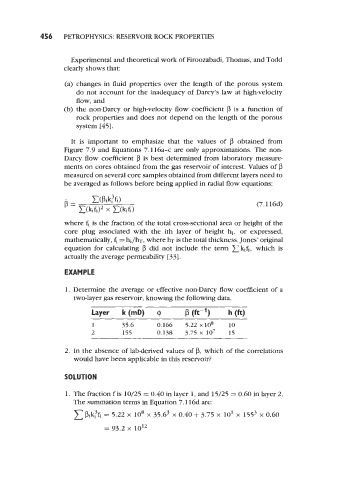Page 488 - Petrophysics
P. 488
456 PETROPHYSICS: RESERVOIR ROCK PROPERTIES
Experimental and theoretical work of Firoozabadi, Thomas, and Todd
clearly shows that:
(a) changes in fluid properties over the length of the porous system
do not account for the inadequacy of Darcy’s law at high-velocity
flow, and
(b) the non-Darcy or high-velocity flow coefficient p is a function of
rock properties and does not depend on the length of the porous
system [45].
It is important to emphasize that the values of p obtained from
Figure 7.9 and Equations 7.116a-c are only approximations. The non-
Darcy flow coefficient p is best determined from laboratory measure-
ments on cores obtained from the gas reservoir of interest. Values of p
measured on several core samples obtained from different layers need to
be averaged as follows before being applied in radial flow equations:
(7.116d)
where fi is the fraction of the total cross-sectional area or height of the
core plug associated with the ith layer of height hi, or expressed,
mathematically, fi = hi/hT, where hT is the total thickness. Jones’ original
equation for calculating p did not include the term kifi, which is
actually the average permeability [33].
EXAMPLE
1. Determine the average or effective non-Darcy flow coefficient of a
two-layer gas reservoir, knowing the following data.
Layer k(mD) @ PW-9 h (fit)
1 35.6 0.166 5.22 xlO* 10
2 155 0.138 3.75 x lo7 15
2. In the absence of lab-derived values of p, which of the correlations
would have been applicable in this reservoir?
SOLUTION
1. The fraction f is 10/25 = 0.40 in layer 1, and 15/25 = 0.60 in layer 2.
The summation terms in Equation 7.116d are:
pik3fi = 5.22 x 10’ x 35.63 x 0.40 + 3.75 x 10’ x 1553 x 0.60
= 93.2 x 1OI2

